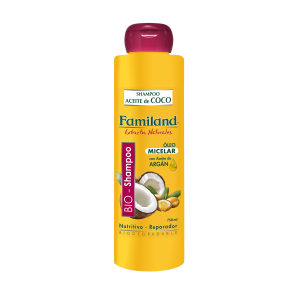Familand Shampoo Aceite Coco Argan

Ingredientes
AQUA
SODIUM LAURETH SULFATE
GLYCOL DISTEARATE
LAURETH-4
COCAMIDOPROPYL BETAINE
LAURAMIDOPROPYL BETAINE
COCAMIDE MEA
PARFUM
PEG-7 GLYCERYL COCOATE
PEG-75 LANOLIN
C12-13 ALKYL LACTATE
PEG-120 METHYL GLUCOSE DIOLEATE
TETRASODIUM EDTA
PEG-60-HYDROGENATED CASTOR OIL
GUAR HYDROXYPROPYLTRIMONIUM CHLORIDE
STYRENE/ACRYLATES COPOLYMER
SODIUM CHLORIDE
CITRIC ACID
METHYLCHLOROISOTHIAZOLINONE
METHYLISOTHIAZOLINONE
ARGANIA SPINOSA KERNEL OIL
COCOS NUCIFERA OIL
Más información
Sin colorantes. Sin parabenos. Protección diaria del medio ambiente. Cruelty Free.
El análisis de ingredientes ha sido elaborado por investigadores del CONICET (*) en base a las siguientes referencias bibliográficas:
- European Chemical Agency (ECHA)
- Loffler, H., and Happle, R. (2003). Profile of irritant patch testing with detergents: sodium lauryl sulfate, sodium laureth sulfate and alkyl polyglucoside. Contact Dermatitis, 48(1), 26-32.
- Final Report on the Safety Assessment of Glycol Stearate, Glycol Stearate SE, and Glycol Distearate. (1990). Journal of the American College of Toxicology, 1(2)
- CIR (Cosmetic Ingredient Review). 2006. CIR Compendium, containing abstracts, discussions, and conclusions of CIR cosmetic ingredient safety assessments. Washington DC.
- Burnett, C. L., Bergfeld, W. F., Belsito, D. V., Hill, R. A., Klaassen, C. D., Liebler, D., Andersen, F. A. (2012). International Journal of Toxicology, 31(4). doi: 10.1177/1091581812447202
- Andersen, F. Alan. “Final Report on the Safety Assessment of Cocamide MEA.” International Journal of Toxicology 18, no. 2_suppl (March 1999): 9–16.
- SCCNFP (The Scientific Committee on Cosmetic Products and Non-Food Products Intended for Consumers) 1999. Opinion concerning fragrance allergy in consumers. A review of the problem. Analysis of the need for appropriate consumer information and identification of consumer allergens. SCCNFP/0017/98 Final. December 199 - Tatyana Hamilton and Gillian C de Gannes. 2011. Allergic contact dermatitis to preservatives and fragrances in cosmetics. Skin therapy letter 16(4), 1-4 .- Anne Birgitte Simonsen, Mette Deleuran, Jeanne Duus Johansen and Mette Sommerlund 2011. Contact allergy and allergic contact dermatitis in children - a review of current data. Contact dermatitis 65(5), 254-65.
- CIR (Cosmetic Ingredient Review). Safety Assessment of PEGylated Alkyl Glycerides as Used in Cosmetics (2015).
- Lanigan RS, Yamarik TA. Final report on the safety assessment of EDTA, calcium disodium EDTA, diammonium EDTA, dipotassium EDTA, disodium EDTA, TEA-EDTA, tetrasodium EDTA, tripotassium EDTA, trisodium EDTA, HEDTA, and trisodium HEDTA. Int J Toxicol. 2002
- 21 Suppl 2:95-142.
- List of Safe and/or Natural Ingredients
- US - FOOD & DRUG Administration (FDA). Generally Recognized as Safe (GRAS) Substances (SCOGS) Database (SCOGS Number 102,1979. Conclusion 1 (dry food packaging), 4 (direct additive)
- CIR (Cosmetic Ingredient Review). CIR Compendium, containing abstracts, discussions, and conclusions of CIR cosmetic ingredient safety assessments (Washington DC, 2006).
- US - FOOD & DRUG Administration (FDA). Generally Recognized as Safe (GRAS) Substances (SCOGS) Database (SCOGS Number 84,1977. Conclusion 1)
- European Commission Legislation (Regulation (EC) N° 1223/2009 y 2019/831, Annexes I to VI and all the amendments to the cosmetics regulation).
- Final Report on the Safety Assessment of Methylisothiazolinone and Methylchloroisothiazolinone. (1992). Journal of the American College of Toxicology, 11(1), 75-128.
(*) Según el ranking SCImago 2020, el CONICET alcanza la segunda posición entre las instituciones académicas y de investigación más prestigiosas de América Latina. A nivel mundial, ocupa la posición 230 entre 7000 instituciones privadas y gubernamentales.

